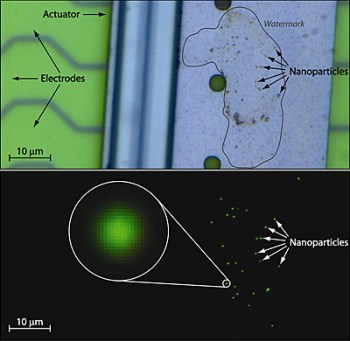Makers of minuscule moving machines—the kind being eyed for nanomanufacturing and assembly as well as other uses—do you know where your micro- and nanorobots really are?
 A micromachine called a scratch drive actuator, labeled with fluorescent dots, (top) rests atop a platform underlain by an electric circuit that initiates the device’s step-by-step movements. Under a fluorescence microscope, the nanoparticles appear as points of light in a starlike constellation (bottom), making it possible to measure small changes in the position and orientation of the device at each step. (Credit: NIST)
A micromachine called a scratch drive actuator, labeled with fluorescent dots, (top) rests atop a platform underlain by an electric circuit that initiates the device’s step-by-step movements. Under a fluorescence microscope, the nanoparticles appear as points of light in a starlike constellation (bottom), making it possible to measure small changes in the position and orientation of the device at each step. (Credit: NIST)
Care to bet?
A team of researchers at the National Institute of Standards and Technology (NIST) likely would likely prevail in such a hypothetical wager. On the basis of its surprising findings in an exacting study of the motions of an experimental microelectromechanical system (MEMS),* the team might even offer better-then-even odds.
The group tracked, for the first time, the step-by-step motion of a standard type MEMS device called a "scratch drive actuator," a micromachine (120 micrometers wide, 50 micrometers long, and 1.5 micrometers thick) that drags itself over a surface by repeatedly flexing and relaxing a tiny hooked arm. Using a novel measurement method adapted from single molecule biophysics research, the researchers tracked and measured each of the device's 500 steps along a 20-micrometer path. They found that the incremental movements varied significantly, from just a few nanometers (nm) to almost 100 nm.
This marked variability in step sizes was "unexpected," says Craig McGray, the first author of the paper. Typically, MEMS researchers have calculated an average step size, derived from the total distance traveled by a device over many operating cycles. The resulting average does not show the variability of the step sizes, while simple models of the behavior of the device have conveyed the impression that the devices move in uniform increments.
Instead, McGray explains, "our method revealed very irregular step sizes, which had neither been observed previously nor predicted by established models of MEMS behavior."
In their proof-of-concept experiment, the NIST team labeled the surface of a scratch drive actuator with fluorescent nanoparticles. Under a fluorescence microscope, the nanoparticles appeared as points of light in a starlike constellation. The position of each point of light was measured with exceedingly high accuracy, rendering the equivalent of a series of constellation maps and capturing the position and orientation of the device as it moved over a surface.
Before and after every step of the device along the path, two images of the constellation were taken. The data were then crunched to determine the step-by-step increments and rotations, and the uncertainty in both values.
With their innovative approach, the NIST team calculated both the size of each movement to within 1.85 nm, (smaller than the width of a strand of DNA) and the change in the device's orientation, also to an exceedingly low uncertainty. Rather than a straight line composed of evenly spaced points, the device took a somewhat ragged-edge route that curved slightly, with each step varying in length and orientation.
In a subsequent test, the researchers measured a second scratch drive actuator made by the same manufacturer. The results also differed unexpectedly and significantly, as indicated by a 26.3 nm difference in average step sizes.
Even as they work to refine their super-resolution fluorescence microscopy method, the team believes the approach can be broadly useful in the area of extremely small electromechanical systems.